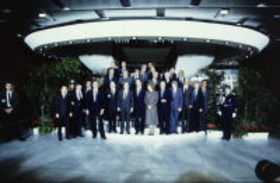Enhanced co-operation

- The European Council must unanimously approve any "enhanced co-operation" (Photo: European Commission)
Enhanced co-operation
Enhanced cooperation is a cooperation where not all member states participate. In 2014 ythe new rules on enhanced cooperation had been used for the European Patent Court and rules on divorce.
The Lisbon Treaty from 2009 permits enhanced cooperation for at least nine of the member states. That nine or more countries must participate. It must also be decided by qualified majority, in foreign and security policy by unanimity.
See the Lisbon Treaty Article 20 TEU and Arts. 326 - 334 TFEU.
For defence cooperation between fewer countries, see "structured cooperation" in Arts. 42.6 and 46 TEU.
The 1999 Treaty of Amsterdam allowed individual member states to establish closer co-operation among themselves using the common EU institutions, so long as any agreements did not affect the "Acquis Commaunautaire" or the Common Foreign and Security Policy (CFSP).
Any enhanced co-operation had to be approved by a unanimous decision of the European Council. This allowed single countries a veto. The provision was therefore difficult to implement and was never used.
From 1 February 2003, the Treaty of Nice allowed enhanced co-operation between at least eight countries, inclusive of the field of CFSP, if a qualified majority approved.
There were, however, some exceptions: areas that fall under exclusive EU competences and defence and military issues.
The European Patent Court is established under enhanced cooperation.
See also Structured cooperation for defence
Notes
Some Euro-critics see enhanced co-operation for sub-groups of EU members as providing the legal basis for a two-tier, two-class EU. If a group of member states large enough to have a majority within the EU decide to make decisions among themselves, they will be able to run the EU without consulting the rest of the member states. Others see it as an instrument of flexibility, the basis for an EU of "concentric cirles".
Links
See also Variable Geometry and Hard Core.
